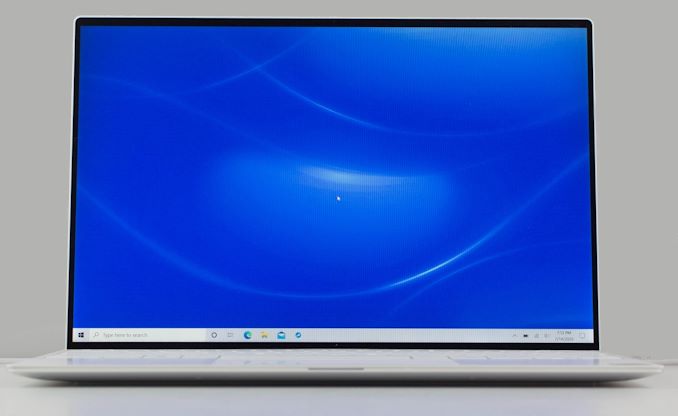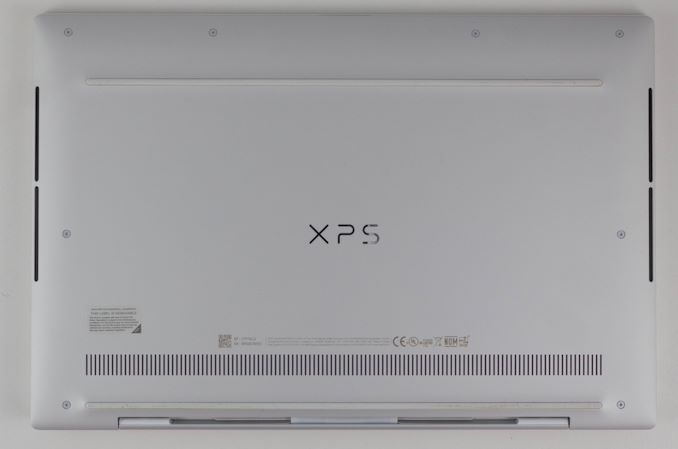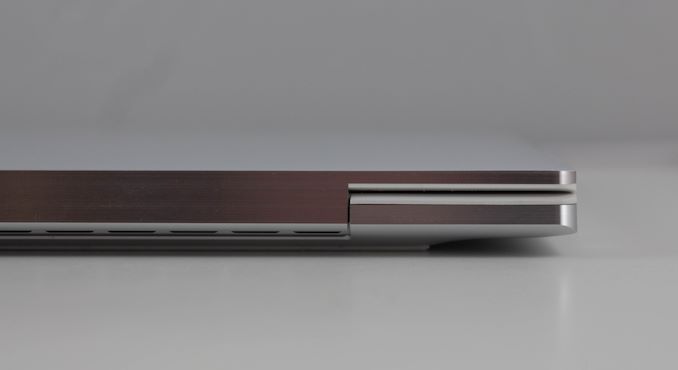The Dell XPS 13 (9300) Review: Return of the King
by Brett Howse on July 16, 2020 10:00 AM ESTFinal Words
Dell’s XPS lineup is one of the strongest in the PC industry. The InfinityEdge display was a revolution, allowing laptop sizes to shrink considerably, while providing the same display size. The new XPS 13 improves on an already excellent pedigree by moving to a 16:10 aspect ratio on the display which further reduces the bezel and keeps the new XPS 13 looking as fresh as ever.
The two color choices are both great, but the Arctic White, with its woven fiber keyboard deck, is really striking. Dell has tweaked this slightly from their original 2-in-1 design by moving back to black display borders, which can help hide the admittedly small bezels even further. The older soft-touch carbon fiber black color is still a great look as well. The refreshed XPS 13 is simply one of the nicest looking notebooks in its class.
The move to Ice Lake in the 2020 refresh is also a welcome addition, mostly thanks to the significantly improved integrated GPU performance, but also because it allows the laptop to support 32 GB of RAM. Coupled with the maximum 2 TB of SSD storage, and the XPS 13 offers plenty of performance for its size. There will be those that lament the lack of an AMD option, as AMD’s latest Renoir is a very potent platform, but the lead time on a notebook like this would preclude that option.
Dell’s decision to move to a 16:10 aspect ratio means that you get a bit more vertical space, which should be beneficial in most productivity scenarios. Of the two display options, unless the wider P3 gamut support of the 3840x2400 display is something critical for a specific workflow, the extended battery life of the 1920x1200 is likely the better option for most people. And, just so it is not forgotten, Dell’s anti-glare coatings are a shot in the arm for the PC industry, providing just 0.65% reflectivity, and when coupled with the very bright display, makes for a winner in almost any lighting condition.
Even the bottom of the XPS is well thought out. Torx screws surround the bottom which allow access inside if needed, and Dell continues to utilize rubber feet which span almost the entire width of the notebook, providing an incredibly solid footprint across a range of surfaces.
Open or closed, the XPS 13 is a fantastic looking device. It backs that up with excellent performance, and plenty of options to fit almost any budget. It is somewhat rare for a premium notebook to start at under $1000 USD, but Dell manages that, if only barely, but the base model now provides 8 GB of RAM and 256 GB of storage, which is much better than some of the XPS 13’s of old, which started with half that RAM and storage for the same price. Dells options are also very reasonable priced, so upgrading from the base model does not instantly launch the price into the stratosphere.
It is great to see Dell update their XPS 13 clamshell notebook to the same internals and design of their previously released 2-in-1 version. It is also great that you can opt for either the clamshell XPS 13, or the convertible 2-in-1, depending on your needs. The convertible offers some increased functionality that you cannot get in a traditional notebook, but there is also a large market that prefers the simplicity of the traditional design. With the XPS lineup, it is your choice.
Finally, in a very rare move, Dell offers not only Windows, but also Linux, giving buyers their choice on what operating system they get. It goes without saying that this is an incredibly uncommon thing on a premium notebook, and very welcome to see. In the case a buyer does opt for Linux, then the the XPS 13 Developer Edition, as it's called, comes from the factory with Ubuntu 18.04LTS.
Overall there is a lot to like about the new XPS 13, and very little to detract from. Dell has yet another winner. With an updated 16:10 display, class-leading battery life, and a fantastic design, the XPS 13 is easily one of the best notebooks around.














224 Comments
View All Comments
Deicidium369 - Friday, July 17, 2020 - link
Leaks from Lenovo show Tiger Lake Core i7-1165G7 (not even the top end part) obviously besting the ancient Vega (AMD's choice) and equaling the MX350 - and with only 4 cores only being outran by 17% - double the cores for 17% lead - and when you factor in the flagging GPU - what's the Renoir's advantage again?gescom - Friday, July 17, 2020 - link
Huh, let's wait for amd 5x00 cezanne, shall we?Deicidium369 - Friday, July 17, 2020 - link
Ice Lake is almost a year old. Comparing the latest AMD with an almost year old design should be a win for the newer part. the most appropriate comparison is 2020 vs 2020. That would be Tiger Lakegescom - Friday, July 17, 2020 - link
Tiger Lake Q4 2020 vsamd cezanne Q1 2021.
s.yu - Saturday, July 18, 2020 - link
You think it's the effort? So they haven't been putting all their effort into 10nm?...ok?
Spunjji - Friday, July 17, 2020 - link
As always for a Deicidium post about AMD, Lots Of Citations Needed."Problem with AMD is they are still trying to get Skylake levels of performance"
- They already matched that clock-for-clock with Raven Ridge (at lower clocks, hence lower overall performance), and they have now exceeded it with Renoir.
"Intel has well moved on from that architecture"
- Not really. I'd accept this if they had Sunny Cove or better across most of their range, but they absolutely do not - not even in notebooks, let alone the entire market.
Tiger Lake looks like it'll be a good release, when it arrives in quantity. Problem is that we're talking about today, not Jam Tomorrow.
Santoval - Friday, July 17, 2020 - link
It is still unclear if Tiger Lake will be a high volume release or a low volume release that will need to be released along perhaps Rocket Lake-U/Y, rehashing the way Ice Lake was released along with Comet Lake-U/Y. It should be higher volume than Ice Lake but maybe not high enough to fully supply the U/Y market on its own.Deicidium369 - Friday, July 17, 2020 - link
Well Ice Lake shipped in greater numbers than all of the Ryzen Mobile - so high volume is a relative term. Ice Lake was going to be low volume and relatively niche. Tiger Lake is high volume (not high volume like the Ice Lake SP Xeon) compared to Ice Lake U.I was surprised to see the 1065G7 in an Inspiron class machine at Dell - I had thought it was only the XPS class machines.
Spunjji - Monday, July 20, 2020 - link
@Deicidium - Of course it shipped in greater numbers than Ryzen Mobile! Intel are ~35X the size of AMD - you'd kind of hope they'd be shipping products in larger absolute numbers. I was talking about Sunny Cove as a proportion of Intel's product range, and I was pretty damn clear about that. It's telling that you flipped metrics under discussion to suit your argument."Ice Lake was going to be low volume and relatively niche" - says who? Why? To what end? You're pointing to the results of a sub-par product launch (by Intel's historically high standards) and claiming it was the plan all along. It's just like the AMD fanbois who used to laud the FX 9590's 5Ghz clock speed as if it was an achievement, rather than the best they could salvage from what they had.
You said Intel have "moved on" from Skylake. That's untrue and will remain the case until Rocket Lake, Ice Lake SP and Tiger Lake are out. At that point in time (and not before) Intel will be fully competitive in all areas on a technical level. I'm genuinely interested to see how Sunny Cove on 14nm looks - there's no reason to believe it won't be solidly competitive with AMD on performance, but power draw and die size might not be quite so flattering.
Santoval - Friday, July 17, 2020 - link
"Problem with AMD is they are still trying to get Skylake levels of performance, but Intel has well moved on from that architecture. Intel is solid as they come in ultralights/ultrabooks."That's a very bizarre statement for quite a few reasons :
1. AMD are not targeting Skylake performance levels. When they designed the original Zen they had in mind Cannon Lake - level performance (Intel semi-released a single semi-disabled Cannon Lake 2-core Core i3 in low volume and now they trying to pretend they never did) and when they designed Zen 2 (according to CTO Mark Papermaster) they were targeting it against Ice Lake - not knowing it would be limited to 4-core low power parts. AMD never had Skylake in mind because they never expected Intel would be stuck so many years with it.
2. Intel have not "well" moved on from Skylake at all. They *just* did, at the beginning of the year (still in low volume, hence the dual release with Comet Lake-U/Y, which was the bulk of the release), with low power 4-core mobile parts and they are *still* stuck with it in the form of Comet Lake. Until Comet Lake is replaced by Rocket Lake Intel are still stuck with Skylake, still fabbing and releasing CPUs with an μarch they have been using, reusing and re-reusing and re-re-reusing since 2015. In which parallel universe would that be regarded as "well moved on from that architecture"?